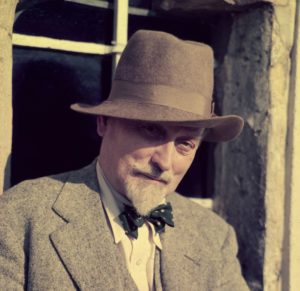A gardener and a suffragette meet by chance on a road by the River Thames. He is carrying a flower-pot, and she is on her way to burn down a house. So starts Stella Benson’s satirical debut novel I Pose (1915), one of the great curiosities of early 20th-century literature, and woefully overlooked.
Stella Benson (1892-1933) was a novelist, poet, travel writer and early campaigner for women’s rights, her feminism galvanised by Emily Davison’s protest at the Epsom Derby in 1913. In the fervid debates between the suffragists and the suffragettes, she eventually favoured the latter’s more militant approach. Yet even as this distinction became a feature of her first novel, Benson did not spare her compatriots her satirical gaze. “How superbly you’ve done the snake that was the soul of the suffrage movement,” wrote Dame Rebecca West. “How lucky you are to have written the only novel of genius about the Suffrage.”
I Pose, in other words, has a wide-ranging ambition that exceeds the merely polemical. Benson’s art is concerned with authenticity, and whether it is even possible within the constraints of our human vulnerabilities. We are performative creatures, insists Benson’s narrator, with an array of “poses” at our disposal. The gardener and the suffragette are never named, but their individuality burns through all the same. Benson may be fascinated by the prison of identity, but has more to say about its occasional ruptures.
Even the novelist is assuming a pose. Describing the suffragette, Benson tells us that “her eyes made no attempt to redeem her plainness, which is the only point of having eyes in fiction”. Her narrative voice is continually reminding us of the futility of its own commentary. She notes that “the gardener had a morbid craving for unpopularity, it was part of the unique pose”, but then adds a kind of rationale: “Unpopularity is an excellent salve to the conscience, it is delicious to be misunderstood.” What is the value of these observations, Benson seems to imply, when they are based on the choices that the author has made about her own creations?
Surprisingly, the result is never alienating; we do not experience in these pages the novelistic equivalent of Bertolt Brecht’s Verfremdungseffekt (distancing effect). This is doubtless a consequence of Benson’s elegant prose style, and a deft poeticism that shimmers with passion and wit. Consider this passage in I Pose concerning the aftermath of a deadly earthquake:
“Distracted men and women panted and moaned and tore at the wreckage with bleeding hands. A little crying crowd was collected round a woman who lay nailed to the ground by a mountain of bricks, with her face fixed in a glare of terrible surprise. By the cathedral steps the dead lay in a row, shoulder to shoulder, with the horrid uniformity of sprats upon a plate.”
As a simple and poignant coda to this scene, a small dog scurries amidst the chaos, “looking for its past in the extraordinary mazes of the present”.
As for women’s rights, Benson teases those readers who might be put off by the prominence of the suffragette in her story. “You need not be afraid,” she writes. “There is not going to be so very much about the cause in this book.” This joyously self-referential quality was to become a recurring feature of Benson’s work. In Pipers and a Dancer (1924), she describes her protagonist Ipsie as possessing a “forest of poses” and being one who “could not escape from the sight of herself”. Ipsie later admits that she is “only copying the heroine of one of Stella Benson’s novels”.
I particularly like Benson’s pose as the strongarmed author in This Is the End (1917), grudgingly following the conventions of her craft: “I might as well introduce you to the Family before I settle down to the story. From careful study of press reviews I gather that a story is considered a necessary thing in a novel, so this time I am going to try and include one.” Uncommon for their time, these kinds of metafictional gestures are rarely intrusive. Benson has an instinct for comic timing and restraint, and the narrative voice never veers from the mischievous to the outright cynical.
Benson sustains this delicate balance throughout her work. It is most notable in her characterisations, which can be barbed without being cruel. Edward in The Poor Man (1922) must surely rank as one of the finest studies of masculine fragility in all fiction. He gropes for our pity and we oblige, while nervously detecting our own foibles in his behaviour. The novel is punctuated with small asides that are intensely revealing. “Edward never, in the whole course of his life, forgot any derogatory personal remark made about himself in his hearing. He luxuriated too much in the criticism of others to forget it.”
It is in this kind of blistering economy that Benson shines. Where some authors might spend whole paragraphs describing their characters, Benson successfully conveys so much of their inner lives through the most seemingly trivial of details. There is Mrs Lorne in Goodbye, Stranger (1926) who “spent every minute regretting the last minute”. As for her husband: “He was a small man of about forty-five. He looked like a large man in miniature.” Even a seemingly throwaway description of a cat in The Poor Man is more suggestive than it needs to be. “It was a parasite of a cat; it prided itself on being a member of an ancient civilisation. It never moved except to move away.”
Such anthropomorphic playfulness is not merely for humorous effect. In Benson’s vision, the natural world is invested with agency, a form of animism that sees humankind as subordinate to a greater, invisible will. Her novels allow us brief glimpses of an oneiric realm, accessible simply by an effort of the imagination. Before the First World War, Benson had volunteered as part of a charity organisation to help the underprivileged in Hoxton. This scenario became the basis for the character of Sarah Brown in Living Alone (1919), who is eventually lured away from her charity work to a house of witches and ghouls. It is one of many instances of the author reinterpreting her own life experiences through a phantasmagorical lens.
One particularly memorable chapter sees two witches — one English and one German — battling on their broomsticks high in the London skies during an air-raid. Whereas Benson’s work often has flavours of magical realism, Living Alone is an episodic prose poem whose entire internal logic is more akin to a dream. Some have connected the author’s affinity for fantasy to her own physical incapacities as a child. She grew up continually on the verge of death, suffering from bronchitis and pleurisy. Her survival was almost certainly a matter of sheer tenacity. “I insist on ignoring the whole condition,” she wrote. “If I must die, I’ll die as alive as I can.”
But if Living Alone is a form of feminist escapism, This is the End is a rebuttal to such indulgences. It tells the story of Jay, a young woman who has run away from home to become a bus conductor. I would describe her as the novel’s heroine, only Benson forbids it. “I cannot introduce you to a heroine,” she writes, “because I have never met one.” Jay does not inform her family of her new occupation, but rather spends her working days plunged in reveries of a mysterious house by the sea. In their attempts to locate her, the family eventually reach the imaginary house Jay has described so vividly in her letters. In doing so, they destroy it.
That Benson was largely confined to her bed for most of her childhood may account for her later determination to explore the globe. She produced two travel books – The Little World (1925) and Worlds Within Worlds (1928) — in which the reader is offered a series of lively anecdotes ranging from America to the Far East. This wanderlust was the stimulus for much of her fiction. Most of her novels are set abroad, and I Pose was inspired by a cruise trip she took with her mother to Jamaica.
Yet Benson’s fascination for unfamiliar cultures might also prevent any possible revival of her literary reputation. The later part of I Pose, located in the West Indies, contains descriptions of indigenous people that are shocking by today’s standards, and would doubtless see Benson dismissed as a racist. Her narrator certainly holds views that are rightly abhorred today, but the fact that no contemporary reviews of the novel commented upon these features should be sufficient evidence that they were unremarkable at the time. Benson’s racial prejudices, in other words, can be readily accounted for by the fact that she had the disadvantage of being born in 1892.
Perhaps Benson’s lineage would be considered even more damning. Her mother was from aristocratic stock, and her family made its fortune in the 18th century through the managing of slaves. Given that the British Library was recently compiling a “watchlist” of authors with family connections to the slave trade, and that activists masquerading as academics are frantically engaged in the “decolonisation” of curricula, the fashions of the moment are clearly unfavourable for Benson’s work to be widely rediscovered.
“A curious feeling: when a writer like Stella Benson dies,” wrote Virginia Woolf in her diary, “that one’s response is diminished; Here and Now won’t be lit up by her: it’s life lessened.” Benson’s death from pneumonia in 1933 in what is now northern Vietnam cut short a talent that was still on an upward trajectory. Her last published novel Tobit Transplanted (1930) was her most acclaimed (Woolf wrote to Benson to say that she envied her for this work) and an unfinished novel published posthumously in 1935 as Mundos could well have surpassed it in completed form.
So while a renewal of interest remains unlikely, Benson’s work cannot be recommended enough. To read her books is to glean a thrilling insight into a singular worldview, one driven by a passion for the unseen and the unknowable. Like the gardener and the suffragette, we become fellow travellers on a strange and exhilarating journey.
Disclaimer
Some of the posts we share are controversial and we do not necessarily agree with them in the whole extend. Sometimes we agree with the content or part of it but we do not agree with the narration or language. Nevertheless we find them somehow interesting, valuable and/or informative or we share them, because we strongly believe in freedom of speech, free press and journalism. We strongly encourage you to have a critical approach to all the content, do your own research and analysis to build your own opinion.
We would be glad to have your feedback.
Source: UnHerd Read the original article here: https://unherd.com/



